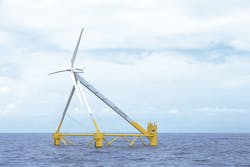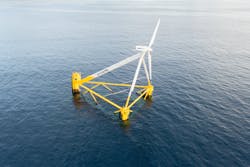TLP mooring system decreases floating offshore wind costs
Editor's note: This story first appeared in the 2023 Offshore Wind Special Report, which published within the September/October 2023 issue of Offshore magazine.
Contributed by X1 Wind
The PivotBuoy Project has been a venture in the world of renewable energy. In fact, the X30 prototype installed during this project became the world’s first fully functional floating wind platform installed with a TLP mooring system and Spain’s first floating wind prototype to export electricity via a subsea cable.
The PivotBuoy Project's main goal was to validate the PivotBuoy single-point mooring (SPM) system in real conditions to reduce the costs of mooring systems and floating platforms as well as to allow for faster and cheaper installation. It also aimed to demonstrate the viability and commercial potential of the PivotBuoy system for offshore wind farms. The project was supported by the European Commission's Horizon 2020 program and involved a consortium of nine organizations led by X1 Wind.
X1 Wind's floating wind platform technology has the ability to passively weathervane and self-orientate through the combination of its SPM system with a small tension-leg platform (TLP), thus eliminating the need for an active yaw. Coupled with a downwind turbine, this enables a complete redesign of the floating structure, removing the traditional tower and creating a tripod-shaped platform that is more efficient in load transmission, which in turn allows a significant reduction of the platform weight when compared to spar and semisubmersible systems. Moreover, the TLP mooring system is not only better suited for deeper waters, as opposed to more widely used catenary mooring lines, but it also decreases the seabed footprint and environmental impact, while enabling higher compatibility with other ocean activities, such as fishing.
Installation
The installation procedure comprises the pre-installation of the mooring system and the later quick connection of the platform, using small to medium vessels for transportation and hookup procedures. This makes offshore operations simpler, reduces possible constraints of the fleet and lowers the installation costs.
The successful final installation of the X30 part-scale prototype at the PLOCAN test site was done in October 2022. In March 2023, the X30 platform produced its first kWh. Finally, the PivotBuoy Project concluded with the decommissioning of the X30 by the end of May, following the official project timeline.
Results
The results obtained were great and well-aligned with simulation models. These included the stability of the platform under normal and extreme weather events, speed and accuracy of the passive alignment, structural behavior, and others. For instance, the results showed the positive passive alignment of the system against the wind speed. The average misalignment was well below four degrees for wind speeds between 5-7.5m/s, and increasingly lower above that. Public data for the average misalignment of active yaw systems is scarce, but the industry average seems to be about four to five degrees since these mechanical systems only adjust after a certain period and magnitude of misalignment. Add to this the low maintenance requirements and high reliability of the components chosen for the passive yaw system and this type of system's advantages become even clearer for large floating offshore wind farms.
Additionally, it is also worth noting that the turbine has been running with the same controller as the onshore version, showing that the stability provided by the TLP enables the platform to have low pitch and roll motions in normal production conditions, and thus this eliminates the need for adding complexity to the turbine power control loop that occurs in some other floater designs.
The project showed that design innovation substantially decreases the cost of floating offshore wind and can be a driver to make this clean energy source competitive with other renewable energy technologies, like solar or onshore wind.


